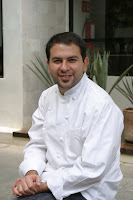
Con sorpresa y tristeza recibimos la noticia del fallecimiento de Don Guillermo Ríos Gamboa miembro de
IACP y fundador del
Centro Culinario Ambrosía en México, sucedida el pasado mes de diciembre 2006.
Don Guillermo fue un personaje importante en la gastronomía mexicana, recordado por promover la educación culinaria y ser "un generoso innovador: constantemente buscaba maneras de impulsar a chefs, como hizo con Ricardo Muñoz, Enrique Farjeat (brazo derecho de Martha Ortiz Chapa, del restaurante Aguila y Sol) y Federico López", por mencionar algunos destacados. Para leer la noticia completa hacer click
aquí.Así lo recordamos, quienes tuvimos la oportunidad de conocerlo durante nuestras conferencias, siempre acompañado de sus colaboradores del Centro Culinario Ambrosia.
En nombre de la comunidad Internacional del IACP, extendemos nuestro más sentido pésame a su familia y colegas de trabajo por ésta irreparable pérdida.
Remembering fellow member Guillermo Rios 1950 -- 2006Guillermo Rios the man whose life work in the Mexican culinary world took him from caterer to school director to magazine publisher, passed away in Mexico in December of 2006.
His commitment to promoting culinary education in Mexico led him to establish the Centro Culinario Ambrosia. The Centro provides a program that is a synthesis of traditional and contemporary techniques as well as practical experience at the student run restaurant Alkimia, a first in Mexico. Practice periods, known as stages, in renowned restaurants in México or Europe are also a must for every student.
Within this vision he helped create the competition Joven Chef Mexicano encouraging young chefs to interact, compete and be judged by leading Mexican chefs. The winners of the competition are then eligible for stages with Juan Mari Arzak or Ferran Adria. Apart from the opportunities afforded by this competition he also provided scholar-ship opportunities within Mexico and now through the Culinary Trust of IACP as well. His generosity in awarding scholarships makes a professional education possible for almost a third of the student body, or over a hundred young people a year.
Creator, director and guiding spirit of Grupo Ambrosia del Bosque which includes Ban-quetes Ambrosia, a major catering company with several facilities in México City, the Centro Culinario Ambrosia, the schools restaurant Alkimia, the magazines Gastronomica de México, Restaurantes, Gastronomía y Vinos, Alkimia, el Arte de Transformarse and Tu Boda as well as founder of the Concurso Nacional Joven Chef Mexicano and the student version, El Concurso Gastronómico Estudiantil, currently organizing its twelfth event. His many accomplishments were remembered by his colleagues Monica Patino, Federico Lopez, Patricia Quintana, and Carmen Ramirez Degollado among many others recently. Their words spoke of a passionate and dedicated visionary whose entrepreneurial endeavors were directed towards the recognition of Mexican chefs and Mexican cuisine in the world forum.
On behalf of the International Committee of IACP we extend our condolences to his family, friends, and colleagues.
Elena Hernández
Chair, IACP International Committee
Ruth Alegria, Mexico Coordinator
 We are very happy and proud to announce that Pasión por el Café, written by IACP member Patricia McCausland, has won the Gourmand World Cookbook Award for "Best Single Subject" in Latin America. The book will now be competing for the "Best in the World" Award. The results will be announced on April 7 in Beijing, China.
We are very happy and proud to announce that Pasión por el Café, written by IACP member Patricia McCausland, has won the Gourmand World Cookbook Award for "Best Single Subject" in Latin America. The book will now be competing for the "Best in the World" Award. The results will be announced on April 7 in Beijing, China.















